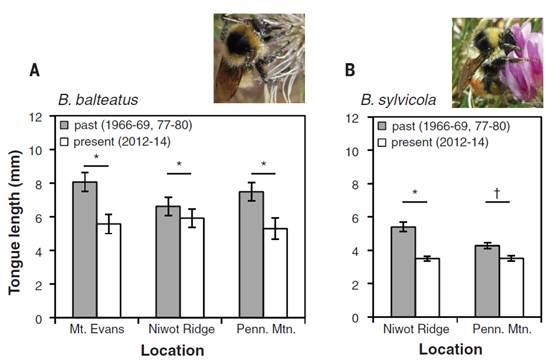花朵数量减少缩短了大黄蜂的舌头
来源:《Science》
作者:Nicole E. Miller-Struttmann等
时间:2015-10-15

据一项新的研究报告,与气候相关的花的多样性改变导致了高山大黄蜂的舌头长度变短,使得这些昆虫因为适应不良而无法对其原先喜爱的深花进行采蜜和授粉。这些结果凸显了某些互利的生态伙伴关系会因为全球气候的改变而丧失。许多同时演化的物种有着精确匹配的特征;例如,长舌大黄蜂能很好地适应于从具有长花冠筒的深花中采蜜。最近的研究表明,长舌大黄蜂的数量正在减少。为了更好地了解其原因,Nicole Miller-Struthman等人对科罗拉多的数个高海拔地点进行了研究,这些地方生活着两种长舌高山大黄蜂。研究人员对1966年至1980年及从2012年至2014年的大黄蜂标本的舌头长度变化进行了测量,他们注意到大黄蜂的舌头长度明显缩短。接着,用存档的大黄蜂标本及对大黄蜂及其宿主植物进行实地调查,他们对这一变化的可能机制进行了检查。他们报告说,该变化并非是因其体型不断变小、入侵者的竞争,或因为与该地区花朵的共同演化的结果。相反,这是夏季气温暖化的结果,因为该暖化减少了这些大黄蜂喜爱的深花数量,迫使这些昆虫成为能对所有剩下的花朵(包括许多浅花)进行摄食的普通觅食昆虫。这转而驱使大黄蜂舌头长度缩短,这是为了生存而做出的一种适应反应。作者们说,这一模式或能在其它系统中预测气候变化对未来的影响。他们的结果凸显了气候变化会如何解除蜂类和植物间公认的互利共生的偶联关系。(来源:生物360)
Functional mismatch in a bumble bee pollination mutualism under climate change
Abstract Ecological partnerships, or mutualisms, are globally widespread, sustaining agriculture and biodiversity. Mutualisms evolve through the matching of functional traits between partners, such as tongue length of pollinators and flower tube depth of plants. Long-tongued pollinators specialize on flowers with deep corolla tubes, whereas shorter-tongued pollinators generalize across tube lengths. Losses of functional guilds because of shifts in global climate may disrupt mutualisms and threaten partner species. We found that in two alpine bumble bee species, decreases in tongue length have evolved over 40 years. Co-occurring flowers have not become shallower, nor are small-flowered plants more prolific. We argue that declining floral resources because of warmer summers have favored generalist foraging, leading to a mismatch between shorter-tongued bees and the longer-tubed plants they once pollinated.
原文链接:http://159.226.251.230/videoplayer/1541.full.pdf?ich_u_r_i=cb38f4dfc66aef80c76cffe5ad2aa654&ich_s_t_a_r_t=0&ich_e_n_d=0&ich_k_e_y=1545098928750163342471&ich_t_y_p_e=1&ich_d_i_s_k_i_d=4&ich_u_n_i_t=1




